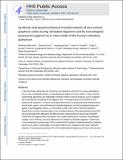Synthesis and Physicochemical Transformations of Size‐Sorted Graphene Oxide during Simulated Digestion and Its Toxicological Assessment against an In Vitro Model of the Human Intestinal Epithelium
Author(s)
Bitounis, Dimitrios; Parviz, Dorsa; Cao, Xiaoqiong; Amadei, Carlo A; Vecitis, Chad D; Sunderland, Elsie M; Thrall, Brian D; Fang, Mingliang; Strano, Michael S; Demokritou, Philip; ... Show more Show less
DownloadAccepted version (2.123Mb)
Open Access Policy
Open Access Policy
Creative Commons Attribution-Noncommercial-Share Alike
Terms of use
Metadata
Show full item recordAbstract
© 2020 WILEY-VCH Verlag GmbH & Co. KGaA, Weinheim In the last decade, along with the increasing use of graphene oxide (GO) in various applications, there is also considerable interest in understanding its effects on human health. Only a few experimental approaches can simulate common routes of exposure, such as ingestion, due to the inherent complexity of the digestive tract. This study presents the synthesis of size-sorted GO of sub-micrometer- or micrometer-sized lateral dimensions, its physicochemical transformations across mouth, gastric, and small intestinal simulated digestions, and its toxicological assessment against a physiologically relevant, in vitro cellular model of the human intestinal epithelium. Results from real-time characterization of the simulated digestas of the gastrointestinal tract using multi-angle laser diffraction and field-emission scanning electron microscopy show that GO agglomerates in the gastric and small intestinal phase. Extensive morphological changes, such as folding, are also observed on GO following simulated digestion. Furthermore, X-ray photoelectron spectroscopy reveals that GO presents covalently bound N-containing groups on its surface. It is shown that the GO employed in this study undergoes reduction. Toxicological assessment of the GO small intestinal digesta over 24 h does not point to acute cytotoxicity, and examination of the intestinal epithelium under electron microscopy does not reveal histological alterations. Both sub-micrometer- and micrometer-sized GO variants elicit a 20% statistically significant increase in reactive oxygen species generation compared to the untreated control after a 6 h exposure.
Date issued
2020Department
Massachusetts Institute of Technology. Department of Chemical EngineeringJournal
Small
Publisher
Wiley